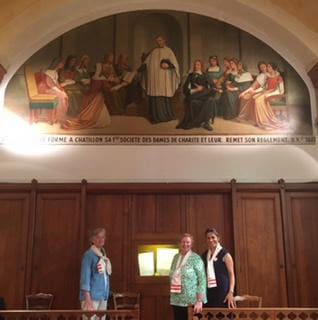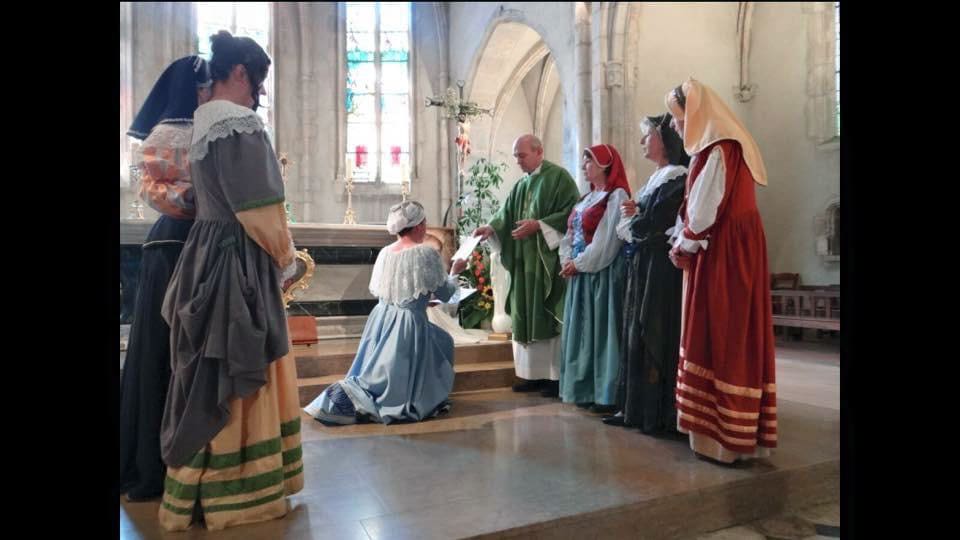The story of the impact of one of Vincent’s early sermons is well known in Vincentian circles, especially among the Ladies of Charity. Indeed, it is their “foundation story.” Four hundred and one years later that story is still being told. But it is a story with even wider implications. It is the story of how St. Vincent went from retail to wholesale.
The story of that sermon at Châtillon is the foundation story for what we call today systemic change. It is an insight into Vincent not so much as a “systems thinker” but as a “systems doer.” He looked at a situation and asked how it could be improved. He knew instinctively what was the next thing to be done.
The house where Vincent lived in Châtillon still stands. The stairs he climbed to his rented room also remain and are used today. One can easily envision him wearily ascending the staircase after returning from a visit to the poor family in which everyone was ill.
Photos of Châtillon 400th Anniversary Celebration courtesy of Dee Mansi, AIC United Kingdom. She writes: Cardinal Gineau of Montauban celebrated the 10.30am Mass in the church of St Andre, Châtillon, Sunday 20th August. The Cure, Parish Priest Dominique Blot acted the part of St Vincent, and six Ladies of Charity, in period costume, entered the church to re-enact the key scene of their first encounter with St Vincent telling him of the poor local family in need.
In St. Vincent’s own words…
One Sunday, when I was vesting to say holy Mass, I was told that, in an isolated house, everybody was ill; there was not even one of them who could render any assistance to the others. This news touched me to the heart. I did not fail to commend them affectionately to the charity of the congregation. God, touching the hearts of those who heard me, moved them with compassion for those poor afflicted people.
After Vespers, I went to visit those people and overtook on the road some ladies who had set out before us and, a little farther on, met some others who were returning home. There were so many of them, you would have said it was a regular procession.
The thing to do was to see how to provide for their needs. I proposed to all those good ladies who had been animated by charity to visit those people that they should club together to make soup, each on her own day, and not only for them but for all who might afterwards come, and that is the first place where the Confraternity of Charity was established. Now, just ask yourselves is that the work of [humans] . . . or is it not quite manifestly the work of God?
(Conference to the Daughters of Charity, February 13, 1646, On the love of our vocation and on helping the poor).
He observes that the family members, who were in great need, are suddenly provided with more than what they can eat. He realizes that part of the food will go to waste, which will return them to the earlier situation of need. In this case, organization was the solution!
Again, his own words years later…
“Since charity toward the neighbor is an infallible sign of the true children of God, and since one of its principal acts is to visit and bring food to the sick poor, some devout young women and virtuous inhabitants of the town of Châtillon-les-Dombes, in the Lyons diocese, wishing to obtain from God the mercy of being His true daughters, have decided among themselves to assist spiritually and corporally the people of their town who have sometimes suffered a great deal, more through a lack of organized assistance than from lack of charitable persons.”[CCD 13b:8]
With that insight he gave birth not only to a branch of the Vincentian Family but to an approach that we are newly rediscovering.
He taught us the importance of consistent strategies, starting on a small scale, delegating tasks and responsibilities and providing quality services, which respect people’s dignity. Vincent thought about a plan, he called a meeting, formed an association and delegated tasks and responsibilities to parish people, whom he included in the process. It is from this small beginning that the whole movement started. (Cf. Roman, Biography of St Vincent de Paul)
Vincent and Louise, and later Frederic Ozanam and Elizabeth Ann Seton, insisted on the fact that services had to be rendered with competence and benefit from adequate resources. Louise, who had great practical sense, worried about anything that was not right, and checked the minutest details so that instructions regarding the execution of tasks were respected. St. Vincent de Paul excelled in the art of making people responsible. He listened to the ideas of others, asked for their opinions and provided the materials that his collaborators needed for the Vincentian mission. He delegated and gave responsibilities to his disciples by pointing to essential values, rules and virtues such as respect and mutual support. He stimulated cooperation as a means to serving the poor.
Reflection Questions
- What elements of the Châtillon story do you see being repeated in your ministry?
- Do you try to look beyond the obvious facts to see what might be a better way of approaching your ministry?
- How might it be possible to enlist others to do collectively what might be beyond the capabilities of an individual?













0 Comments